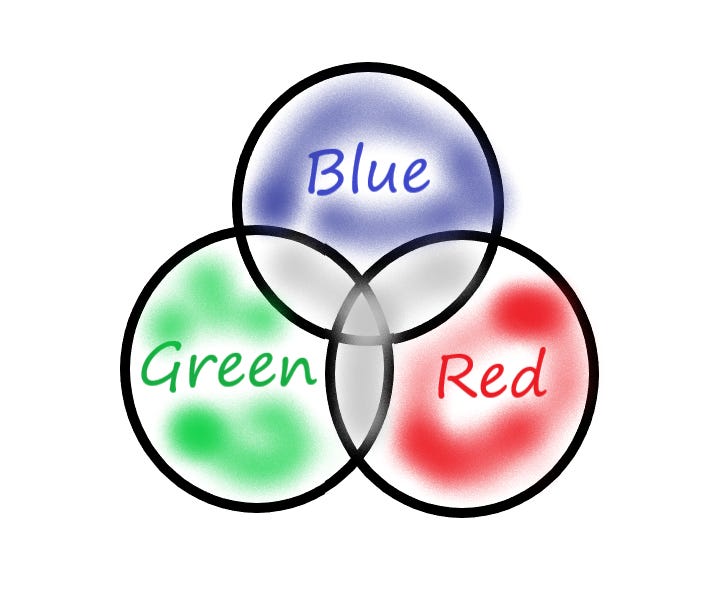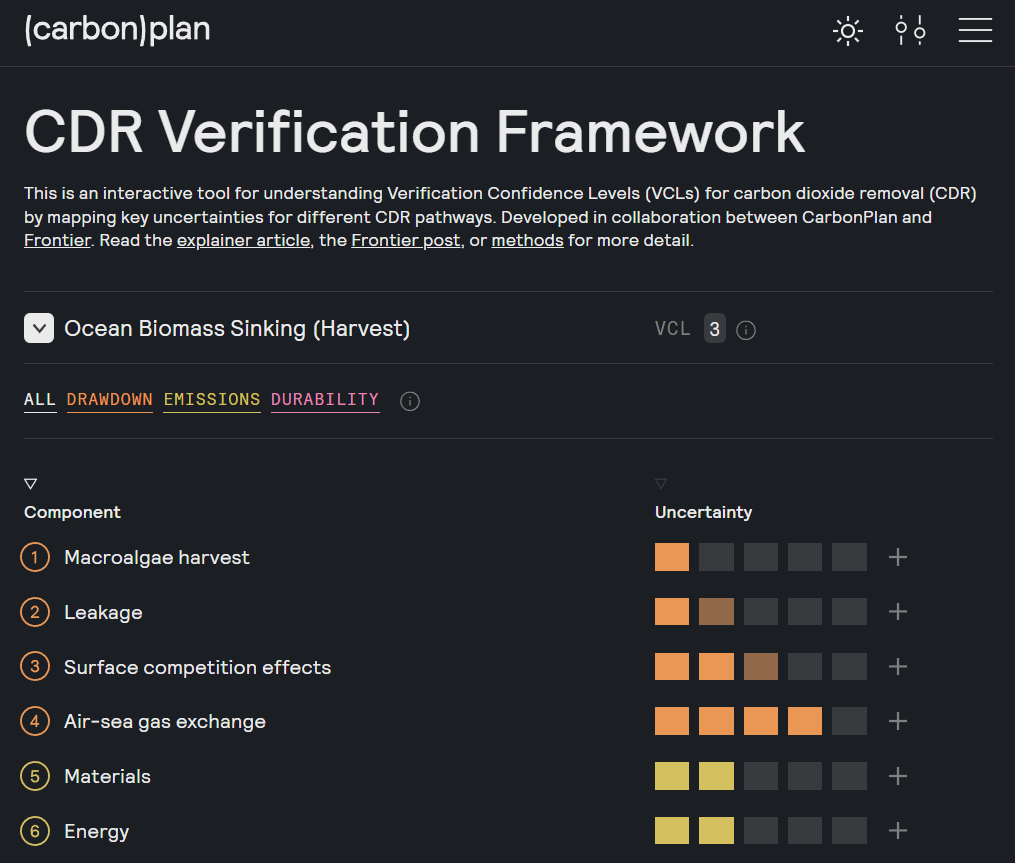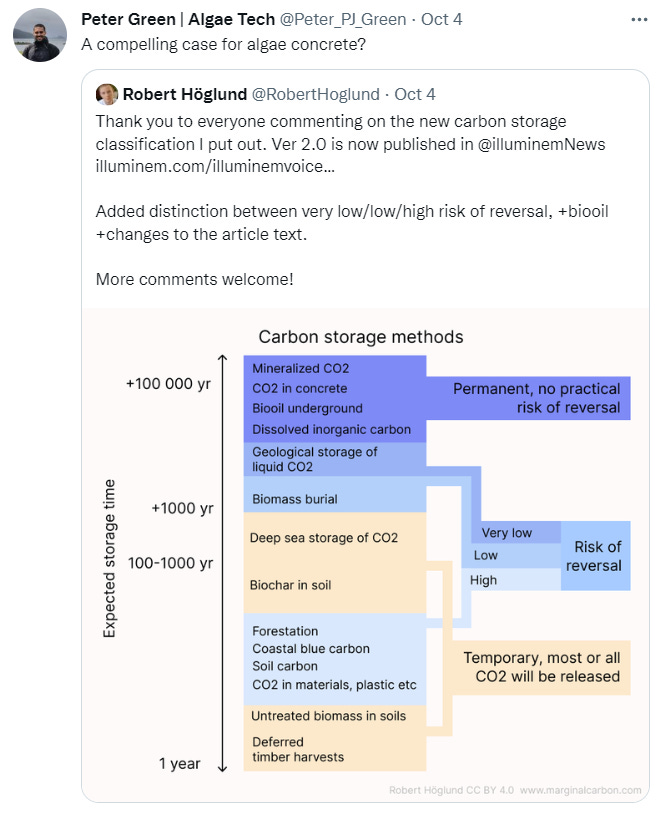🌍Algae tech, supply chains and biodiversity with Hampus Jakobsson
PLUS: 💸 Hatch Blue announces the first close of its Blue Revolution Fund, and one.five raises €10.5 million in seed funding
"If you can increase the margins for companies, decrease the price for consumers and provide something that’s better for the world, you’ve really nailed it." — Hampus Jakobsson, Pale blue dot
Dear algae technologists - hello and welcome to the Paxtier Report!
This week, why not spend some time with (carbon)plan's handy new verification tool:
You can use this to compare various CDR pathways and uncertainties.
See more (HERE)
In today’s report:
Markets: 💸 Hatch Blue announces the first close of its Blue Revolution Fund
Deals: 🤝 one.five has raised €10.5 million in seed funding
Movers and Shakers: 🌍Algae tech, supply chains and biodiversity with Hampus Jakobsson
Around the web: 💡 Tech Nation’s Net Zero programme welcomes 3 algae engineering companies into the cohort
Markets and Investing
✂️Algae Market Snippets
Some recent big moves:
An exploratory project to investigate the benefits of farming seaweed in the open ocean has been selected for funding from Princeton’s Dean for Research Innovation Fund for the Sustainability of Our Planet. (Read more HERE).
Current Foods reveals sliced plant-based smoked salmon at Expo East (Read more HERE).
Tech Nation’s Net Zero programme welcomes 3 algae engineering companies into the Net Zero 3.0 cohort "@kelpindustries is using algae to create bioplastics, @phycobloom are engineering algae to create sustainable biofuels, and @phycoworks are using synthetic biology and machine learning to produce algae at scale." (Read more HERE).
CH4Global update us on the first commercial on-farm use of its seaweed supplement (Read more HERE). And HERE’s news of CirPro plating up methane-reduced seaweed steak.
Seaweed Generation has raised $1 million from AeraVC and Graph Ventures to scale up its novel carbon removal technology. (Read more HERE).
US lawmakers introduce bill to create national seafood marketing council (Read more HERE).
The Nordic Cleantech Open announced its Top 10 innovative, promising, and ready-to-scale companies (Read more HERE).
Swedish renewable energy developer OX2 has signed letters of intent with companies Kobb and Nordic Seafarm to investigate opportunities for large-scale cultivation of seaweed at its Galatea-Galene offshore wind farm in Sweden (Read more HERE). Kobb also raised capital to expand its operations from test cultivation to full-scale. (Read more HERE).
Alaska’s kelp farming industry hits tricky hurdle, despite high global demand (Read more HERE).
The Tamil Nadu government is on a mission to make the state a one-stop destination for the seaweed sector (Read more HERE)
A solar hybrid power plant, expected to provide 24/7 electricity to two municipalities in Mindanao, was launched this week. The initiative is part of the Renewable Energy Technology for Seaweeds Value-Added (RETS) project between the EU, the Mindanao Development Authority, the United Nations Industrial Development Organization (UNIDO), and local stakeholders. (Read more HERE).
Connecticut Sea Grant receives $850,000 in federal funding. (Read more HERE).
Maine seaweed company bids for more growth, signs deal with business backed by celebrity chef (Read more HERE).
Sustainable Development Technology Canada (SDTC) announced an investment of $18.7 million in six innovative Canadian companies. Notably, Cascadia Seaweed recieved $4.3 million to further develop its seaweed-based agriculture feed supplement. You can also access Cascadia’s fundraising round HERE.
Sea & Flour launches seaweed bread. (Read more HERE).
AlgaeCal partners with OsteoStrong to promote bone building (Read more HERE).
Seastock completes first harvest of Asparagopsis in Western Australia. (Read more HERE).
Welcoming local NGOs as hub partners in Ghana, Namibia and South Africa: From Seaweed Education to Human Rights Legal Support.(Read more HERE).
Isle of Wight's Ventnor seaweed removal bill tops £100k. (Read more HERE).
$2.25M Awarded to Develop Sustainable Energy Products from Waste Streams -Researchers will create sustainable aviation fuel and graphite from a blend of wood waste and seaweed. (Read more HERE).
UC San Diego announces second cohort for Blue Economy Accelerator, specific for start-ups dedicated to tackling ocean-focused challenges and solutions. (Read more HERE)
Pacific Northwest could soon double or triple its number of seaweed farms. (Read more HERE).
Kate Moss to sell seaweed products for medical purposes under her Cosmoss company. (Read more HERE).
Indonesia explores strengthening its cooperation with Russia in an effort to increase seafood export to the country. (Read more HERE).
NOAA Sea Grant announces $14 million in investments to strengthen U.S. aquaculture. The competitively selected projects will advance early-stage propagation strategies for various aquaculture species, marine finfish juvenile production technologies, aquaculture collaboratives and establishment of an aquaculture information exchange. (Read more HERE).
Atlantic Sea Farms launches two new Sea-Veggie Burgers (Read more HERE).
Sun Chemical launches SUNFOODS natural colorants for food and beverage. (Read more HERE).
one.five has raised €10.5 million in seed funding for its biomaterials and biopackaging play. (Read more HERE).
Lofoten Seaweed are launching a new range of products - spice blends. (Read more HERE).
Check out Reuben Oliver, a start-up disrupting the traditional knitwear category. The team’s products are handmade in Peru using materials including seaweed. (Read more HERE).
New estimates available for commercial production of methane-reducing seaweed for livestock (Read more HERE).
PlantSea receives £462,000 from Innovate UK Smart Grants. The company will use this capital to further develop its seaweed-based packaging and expand the team. (Read more HERE).
Hatch Blue announces the first close of its Blue Revolution Fund. (Read more HERE).
Katapult Ocean officially launched its 2022 Ocean and Climate Accelerator Program - and several algae teams were featured including Algae-C and Carbonwave. (Read more HERE).
Algiecel secures DKK 1.2 million from Innovation Fund Denmark.(Read more HERE).
Kao joins Geno as a founding member in its 120M+ venture to globally scale palm oil alternatives.(Read more HERE).
Algae waste to become food and cosmetics in circular EU project (Read more HERE).
MARI Oceans unveils funding partnership with Deliberate Capital and Swiss Re Foundation to enhance current seaweed farming practices in Indonesia. (Read more HERE).
Stemcell United Limited has signed a binding Memorandum of Understanding with Baker's Oven Food Services Pte Ltd to supply seaweed based products to Oceania. (Read more HERE).
Haarslev and Grön Fuels form strategic feedstock, marketing, and investment alliance (Read more HERE).
In depth with Peter Green
🌍Algae tech, supply chains and biodiversity with Hampus Jakobsson
Hampus Jakobsson is the founding partner of Pale blue dot, a climate tech VC firm based in Malmö, Sweden.
Last year, I had the pleasure of speaking with him about work, supply chains, and algae tech.
Here are the best bits from that legendary chat:
How has Pale blue dot evolved to where it is now?
Pale blue dot is run by three general partners: myself, Heidi Lindvall and Joel Larsson. I met Heidi whilst advising her previous start-up, and I initially met Joel after angel investing in one of his companies.
In terms of my path into climate-tech, I’m originally a computer scientist and come from a deep-tech family. My entrepreneurial journey started when I was 20, when I stumbled into building an art exhibition by mistake. This project quickly evolved into a business which attracted plenty of attention, including from Sony Ericsson, who invited us to create a PlayStation phone. We weren’t initially interested, but their director was persistent and offered $50,000 per phone model, equal to the largest amount we’d previously been paid by an art venue. Sensing the greater opportunity, we pivoted away from art exhibitions, and over the following years built a company from six friends to 180 people with offices in Taipei, Tokyo, San Francisco and Chicago.
Post-scaling, we were eventually acquired by BlackBerry, whereupon the CEO asked me to run M&A for the company. After some deliberation I accepted and, in hindsight, I think this was a great lesson for me. It taught me the importance of finance. As a kid, I’d believed that science changed the world. As a result, prior to that acquisition, I’d lived 15 years of computer science, entrepreneurship, and building. During those two years at BlackBerry, I realised that real change came when you combined depth, entrepreneurship, and finance. So, that’s when I started angel investing.
After investing in 100+ companies, I then took the opportunity to join a deep tech fund in Berlin. That’s where I really started to look at more climate companies. Climate’s particularly interesting because it remains a very gnarly topic. You need everything including depth, science, entrepreneurship, and action-orientation. I made several deals at that fund but realised how hard it was to change the venture model to suit the needs of climate. As a result, I decided to leave and eventually created Pale blue dot with Heidi and Joel.
We created Pale blue dot for several reasons. Principally, it was and remains frustrating that there aren’t enough early-stage, operator-led climate-tech funds. As a result, there are few who know how to be in the trenches with early-stage founders. This is mainly because it’s a nasty stage to be in. You have to do a lot of stupid bets. A major challenge relates to assessing founders. Do they really want to change the world for the better? Will they stay the course? Or will they sell their technology to the military instead? I jokingly say that it’s a combination of Texas Hold’em and reading papers. The technical stuff is searchable, but picking people is a real bet. As a team, we’d previously done 150 odd investments in start-ups and people. As a result, we believe that we are well placed to pick the right people.
Given your previous investments in algae-tech, what’s your opinion on the space?
In general, the biggest problem with algae-tech relates to demand. How can you create something which has a natural demand? At the end of the day (part-joke, part-truth) if you’re selling to a company they care about three things, and if you’re selling to a person, they care about three other things. Companies care about increasing revenue, decreasing cost, or decreasing risk. Therefore, when you start talking about increasing biodiversity, you’re not checking one of those boxes. Meanwhile, consumers care about getting “paid, made or laid.” Are you going to tick one of those boxes with an algae product?
You need to nail one of the following components: reduced price, increased convenience, or better quality. Right now, algae doesn’t really check any of those boxes. That’s a problem.
Despite this, there are some exceptions to the rule. For example, our portfolio company bettaf!sh positioned its algae product as an alternative to tuna, but as it isn’t from tuna it isn’t only better for climate, it is naturally cheaper. Using algae instead of tuna comes with additional benefits like increasing biodiversity, creating local jobs, and providing consumers with healthy food. When they position their product in this way, the buyers say “wow, you’ve made a better tuna” and few need to “care” that it’s algae. They can capture buyers who care about price and health. If you can increase the margins for companies, decrease the price for the consumer and provide something that’s better for the world, you’ve really nailed it.
Where do you hope to see more innovation and solutions?
There are many problem areas but we are thinking particularly hard about saving biodiversity, moving pension fund money and improving supply chains.
I’m super interested in biodiversity. I think we’re going to wake up one day and realise that we’ve missed the problem. We’re all talking about carbon, but we don’t talk about the thing that creates it. When we fixate on carbon that way, then carbon offsetting works and planting eucalyptus trees works, but these solutions can be terrible for biodiversity. Ecosystems are highly complex. They need a predator-prey system, they need different hierarchies, and different things keep everything in check. I fear that we’re building a system where we promote the destruction of biodiversity in the name of climate.
Another area of interest revolves around moving pension fund money. Pale blue dot is a $100 million fund. As a result, our biggest job involves picking the right people. When it comes down to investing big money into these teams, we’re simply not enough by ourselves. In order to figure out climate change, we need to move pension fund money into these ventures.
In addition, we’re also hoping supply chains become shorter and more transparent. Currently, we have a system designed to promote cheap labour and separate production from consumption as much as possible. We have no transparency around environmental variables like water consumption for example. Although the markets only worry about price, we’ve seen massive price spikes in 2020 which show how we cannot control anything, least of all prices. How broken are other variables in the supply chain? What about things which hurt the environment? How much exponentially worse are these secondary variables compared to price? There’s a huge need to create transparency so we can really understand what’s going on. Improving this area can have massive benefits for communities and climate.
What books might you recommend to someone else who’s just starting out on this journey with climate-tech?

I propose a Venn diagram perspective on this which separates books into three main areas: red, blue, and green. In the blue sphere, you have books by technologists like Bill Gates, who suggest that we need to invest heavily into technology. His book “How to Avoid a Climate Disaster” is the most prominent in this area. Then you have the green sphere, which proposes a degrowth approach. Things like eat less, travel less, buy less. If you read Arne Næss for example, on extreme green, you would think about ecology a lot better and the degrowth movement. The problem with that circle is that it only works if the majority does it. When comparing the blue mindset with the green, I think blue generally wins. Nevertheless, there are certainly things we should reduce because some problems are very hard to solve through technology alone. Our attitude towards buying new things all the time as a society is one such example.
Finally, we have the red circle, which highlights that we need to change the economic system. People in this corner argue that we are now profiting by destroying the planet. Of course, the reds are really right about many things, but the problem with this corner is that it can oversimplify the challenge as a fight against capitalism. If you go too far in that direction you can create a world where certain kinds of innovation are inhibited.
My favourite book in the red sphere (and the book I think most people should read) is “How to Blow Up a Pipeline”. When you’re reading that book, you see how the legal system is actually protecting exploitation. In addition, the author explains how we need to discuss topics in order to force the hand of the system and create drastic change.
🐦Tweets of the week
🔥 What else was hot in algae tech?
Sustainable Ocean Alliance is transforming from accelerator To ‘Ecopreneur Network’. (Read more HERE).
(Paper) The combined impact of low temperatures and shifting phosphorus availability on the competitive ability of cyanobacteria (Read more HERE)
Earth's algae and moss could survive under the light of another star. (Read more HERE).
Algoliner is revolutionising microalgae cultivation with mobile factories. (Read more HERE).
10 Seaweed packaging start-ups you need to know (Read more HERE).
Factors influencing the consumption of seaweed amongst young adults. (Read more HERE).
The biggest opportunity in climate tech — in numbers. (HERE)
(Paper) Bioactivity of crude fucoidan extracted from Sargassum ilicifolium (Turner) C. Agardh (Read more HERE)
In seaweed, climate capitalists see green - A boom in seaweed farming is being sold globally as a climate solution, but some Indigenous nations and local harvesters are sounding an alarm. (Read more HERE).
Using native algae to cut leaching. (Read more HERE).
DOE Releases roadmap to achieve carbon neutral aviation emissions. (Read more HERE).
This vertical farm grows carbon-neutral algae next to a geothermal power plant. (Read more HERE).
Microrobots deliver targeted therapy to treat bacterial pneumonia. (Read more HERE).
Eutrophication Continues to increase in Blue Lakes due to climate change. (Read more HERE).
Ocean currents, sand dunes and algae: NASA satellite photo. (Read more HERE).
Check out Equil – a team on a mission to fuel planes and ships with seaweed. (Read more HERE).
Phycobloom have made it into the Breakthrough Energy Fellowship. (Read more HERE).
German-made device gives Toledo plant operators real-time algae data. (Read more HERE)
A viable alternative? - Despite repeated failure in commercial biofuel production with algae, investors have not given up hope. (Read more HERE).
The potential of microalgae biomass as a renewable resource. (Read more HERE).
Creative BioMart releases one-stop algal expression services. (Read more HERE).
Energy from algae: first plant in Cilento. (Read more HERE).
Growing spirulina - New Zealand Algae Innovations Ltd currently operates the ‘only spirulina farm in the country.’ (Read more HERE).
Algae with artificial intelligence could clean wastewater in the future. (Read more HERE)
Botter’s sustainability at scale: Caribbean couture made with algae and ocean plastic (Read more HERE).
Solving food's biggest future challenges is a family affair for this Israel alt-protein specialist. (Read more HERE).
Algae as microscopic biorefineries. (Read more HERE).
What is Blue Carbon? (Read more HERE).
An overview of the algae industry in Europe. (Read more HERE).
Australian start-up Oceanfarmr helps jump blue economy hurdles. (Read more HERE).
The surprising Swiss-Army-knife-like functions of a powerful enzyme found in blue-green algae. (Read more HERE).
Marine phytoplankton get by with a little help from bacteria. (Read more HERE)
Scientists are hopeful that tiny ocean zooplankton will help us tell whether climate change targets are met. (Read more HERE).
Bank of the West creates a disappearing billboard to bring awareness to disappearing kelp habitats. (Read more HERE).
Study raises concerns about contaminants in edible seaweeds. (Read more HERE).
What I do: I’m the fourth generation to harvest seaweed for our family’s baths in Sligo (Read more HERE).
That’s all folks!
Thanks again for joining us this week. Hope you have a great day and stay tuned for more algae tech updates soon!
Peter







